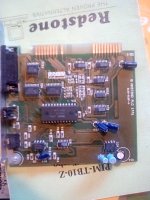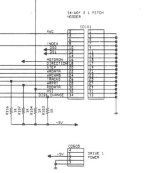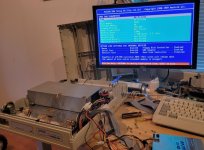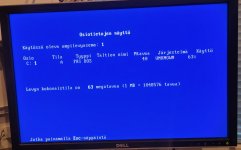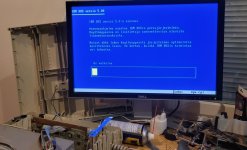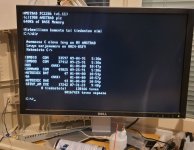Thanks Modem7 for that!
However, I had some time yesterday evening to fiddle with Amstrad and got some happy news to report!
I decided to try out if my earlier 2286 motherboard works with this working unit PSU. I took the motherboard,
just the main board, not the extension board that has ISA slots and the Paradise vga chipset. Connected the main board
with the new unit extension and psu and tried it out.
And it was working! The motherboard I mean. Floppy drives were still struggling, but I did notice improvement there as well.
Instead of hanging at boot attempt, the floppy drive was moving head and trying to read. And it failed to read, reported
non dos disk, please input boot disk - not word for word, but what you would expect. That was already great, since the other
motherboard just hangs and won't respond to keyboard after that.
I had at least four dos boot disks. All 1.44 floppies failed to read, but there was one original IBM PC DOS 5.0 disk that was DD 720kb
floppy. And just one of the two Amstrad original floppy drives agreed to read it!
Oh the joy, when the Amstrad 2286 finally booted for the first time in who knows how many years! At this time I did not have
any hard drive or controller card installed at the computer. The boot took really long, so I decided not to turn off the Amstrad. Instead
I used another pc to make diskcopy of that 720kb IBM PC floppy disk. I just happened to have NOS DD floppies, full set of 10.
I opened that DD floppy box and made a disk copy of IBM PC DOS disk to brand new (old stock) floppy. And put the sticker on the
floppy - now that is another thing you do not do every day any more

.
While at it, I also moved the Amstrad 2286 setup.exe to a 720kb floppy. And run it on the Amstrad 2286. I have probably never
run that setup on these computers before. I had my 2286 only for a short time back in -91 because thunder storm killed it in about one year.
Next, I wanted to setup my hard drive. It is actually 40 megabyte WD384R. But what type is it? I seeked information here:
While great link and good information, the link above suggests 40 megabyte drive to be set at Type 17 in the Amstrad 2286.
I learned that the type number differs from IBM PC and other clones, so there is no one universal answer to a correct HD type number at bios.
I followed the instruction and put HD type 17 at 2286 BIOS and saved. I expected the computer to boot after installing the HD and driver card,
but it failed to do so from hard drive. I was still able to boot from my original IBM PC 5.0 floppy - but curiously, not from the replica I made!
The floppy drive seems very weak and I may still need to replace it with IBM PC floppy, if I can just make one work.
I checked what fdisk says. It claimed the hard drive to have maximum space of 63 megabytes! Of which 40 megabytes were used. That is
wrong of course so I tried to remove main DOS partition and recreate it to properly initialize the drive. That failed in a crash. After second
boot, the fdisk still showed 63 megabytes size. I figured that BIOS setting type 17 was wrong and meant for the 65 megabyte drive used in Amstrad 2386.
But what would be the correct HD type then? I could not find good answer on-line so I used my gut-feeling. The 40 megabyte drive was the
first as standard so I just put the type 1. and I just happened to be correct !
Indeed the fdisk now showed correct size. C: drive was not immediately accessible after boot, but format c: would work without recreating
the partition. And I was able to install IBM PC DOS 5.0 partially, since I had only that one floppy and not the second and third of the set.
In any case, the 2286 now boots from the hard drive! I put fresh BIOS batteries to keep settings alive. The cable is very short and I may make
a mistake of pulling the batter wire open. Hopefully, if that happens the weak floppy still boots.
For now I'm really happy. But I still want to replace that original floppy drive away. It only seems to work as DD drive, it won't read or format any 1.4Mb
floppies. Even though it is set correctly at BIOS as a 1.44 Mb drive.


